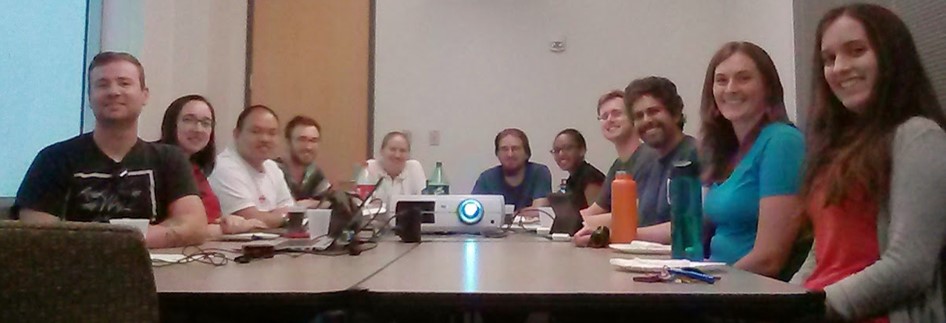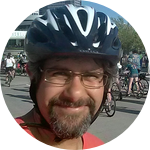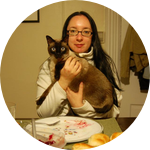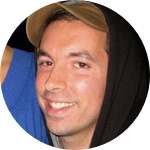About This Project
Global climate change is due in large part to increasing levels of atmospheric carbon dioxide that result from human activities such as deforestation and burning of fossil fuels. This project aims to better understand how we can combat global warming by recycling this unwanted greenhouse gas into something more useful and benign: methanol. Methanol is a clean burning and environmentally friendly fuel that can replace gasoline in automobiles.Ask the Scientists
Join The DiscussionWhat is the context of this research?
A group of chemists at the University of Texas at Arlington recently reported the successful conversion of CO2 into methanol with 95% efficiency and minimal by-products using sunlight and oxidized copper nanostructures as catalysts. In other words, simple and abundant catalysts such as sunlight and rusty copper (imagine the Statue of Liberty) can be used to reduce CO2 levels in the atmosphere!
While these results are very exciting and promising, we do not yet understand exactly why these particular oxidized copper nanostructures would convert CO2 into methanol better than other common catalysts would. Identifying the role of the nanostructures in the conversion process is therefore an important step toward refining and developing this and other catalysts for widespread commercial use.
What is the significance of this project?
The ultimate goal of our project is to understand why oxidized copper is so great at converting CO2 into methanol. We are in a unique position to do this because we can provide detailed images that show exactly how the process occurs, step by step, one molecule and/or atom at a time.
With your support, we can extend our preliminary work to determine exactly how the oxidized copper catalyst aids in the conversion process. This will help us, and others working toward the same goal, design even better catalysts that can be potentially be implemented commercially.
What are the goals of the project?
Our proposed research is critical in understanding exactly how the oxidized copper nanostructure converts CO2 into methanol (CH3OH). We first approach the problem by studying how an individual CO2 molecule interacts with the catalyst. Specifically, how does it attach such that it can still move around and find other reactant molecules? How then does the catalyst use sunlight to help break down water (H2O), a key component in providing the necessary hydrogen (H)? Finally, how does the catalyst facilitate the reaction between CO2 and H to produce methanol?
We can answer these questions by imaging the different steps of the process using scanning tunneling microscopy (STM). STM allows us to 'see' individual atoms and molecules and is explained in the "STM 101" Lab Note.
Budget
The proposed budget would support this project for approximately one month.
Liquid helium: To study the behavior of single molecules and atoms, we have to make sure that they stay still long enough to observe them. This requires liquid helium, which has a boiling point of -270 deg C / -452 deg F (or 4 Kelvin!). When we cool our STM with liquid helium, the molecules are so cold that they stay put indefinitely. We can move them around if we need to, but that type of precision and accuracy also requires that the microscope be cooled to cryogenic temperatures.
CO2, water, and methanol: Although we were able to obtain preliminary data for CO2 interacting with our model catalyst, we borrowed a CO2 cylinder from another lab to try that experiment. The good news is that we know that the experiment will work, but we need to purchase our own high purity cylinder before we can move forward. The same applies for both water, which provides the necessary hydrogen atoms, and methanol. Independent experiments with methanol are key in confirming that the conversion process has completed successfully.
Researcher stipends: Unfortunately, the experiments don't do themselves! We currently have no other source of funding to staff the project, and what we're proposing here is minimal and sincerely appreciated.
92% of your contribution may be claimed as tax-deductible (as Experiment charges an 8% fee)
Meet the Team
Team Bio
I was always interested in Chemistry and Physics, and in fact double majored in these subjects at the University of Illinois, Urbana-Champaign. I maintained an interest in Chemistry while doing my PhD in Physics at the University of California, Santa Barbara. I then learned the STM technique to be used in these studies as a postdoc at IBM's Almaden Research Center in San Jose, CA. I started as an Assistant Professor of Physics at Ohio State in 2004 and am now an Associate Professor. My group at OSU works to develop an atomic-level understanding of processes relevant to future energy and information technologies.I am an avid reader (David Brin to Edward Gibbon), whistler (a pleasure for my labmates I can assure you!), and bicyclist. This summer I rode 180 miles to raise money in Pelotonia, OSU's grassroots cancer funding ride. If only I could ride to raise money for my group's research, I'd be in much better shape!
To learn more about Nancy, Steven, and Kirtus, please visit their bios!
Jay Gupta
My current research interests are focused on developing an atomic-level understanding of processes relevant for energy and information technologies.
I'm an avid reader, bicyclist and whistler.
Nancy Santagata
Like a lot of people, I found my high school chemistry course to be overwhelmingly incomprehensible. I recall enjoying my physics course, but my report card clearly indicated that said physics course didn’t reciprocate the feeling. I had no problems with my life science courses, so upon arrival on campus as a college freshman I proudly declared myself a biology major. I quickly realized that while biology was interesting, I missed the problem solving inherent to chemistry and physics. My small liberal arts university didn’t offer physics major, so I decided to give chemistry another shot.
As part of an internship-style graduation requirement, I spent a summer working in an academic research lab at Penn State University. There, I discovered STM, a technique that combines aspects of both chemistry and physics and that is actually very similar to one of my hobbies, photography. I became hooked and never looked back. After graduating with degrees in Chemistry from Monmouth University (in NJ) and the University of California, San Diego, I eventually rounded out the collection with a PhD from North Carolina State University.
When I grow up, I want to be an astronaut. While waiting for a viable ride into space, I spend my days on the Ohio State campus, tinkering in the Physics building, teaching chemistry to large masses of undergrads, co-advising both the Chemistry Club and the Jump Rope Club, running a blog about life in physics, and in general trying to convince people that chemistry and physics, when given a chance, can be a much more fulfilling adventure than what we typically encounter in high school.
Steven Tjung
Ever since I was a little kid, I’ve always liked to tinker with my toys. Usually, this involves me taking apart a toy to figure out how it works. At first, it ended with my parents yelling at me when they saw their cassette player in pieces. But eventually, I was able to put them back together and have them in working condition. This is where I started to develop an interest in engineering. In high school, I really enjoyed my physics course and realized that the field has so much to offer. So, I decided to major in Physics at University of California, Riverside (UCR). As an undergraduate, I had the opportunity to work in Dr. Kawakami's research lab where I learned molecular beam epitaxy (MBE). MBE is a way to grow a single crystal thin film atom by atom. You can think of it as spray painting with atoms. I also learned to work with ultra high vacuum chambers, which involved lots of wrenches and was as fun as my toys (except the vacuum chambers are a lot more expensive than a cassette player). It was not until my junior year that I found out about scanning tunneling microscopy (STM), where I can image atoms. This is when I told myself that I want to become an expert in not only growing thin films atom by atom, but also looking at and studying those atoms. After graduating from UCR, I become a PhD graduate student in Dr. Gupta's lab at The Ohio State University where I can learn more about STM. When I am not doing physics, I have many hobbies to keep me occupied. I like to play many instruments (guitar/bass/mandolin), tinker with my car, take pictures, and ride my motorized skateboard.
Kirtus Moon
Curious. That's how my parents would describe me. As a child, I often tortured them with the infinite "Why?" loop until they finally broke down and bought me some science books to keep me quiet. In high school I took every science related course that was offered (including a 3 hour per day physics course!) to feed my appetite for knowledge. Science is not my only passion however, and upon graduating high school I pursued another interest: Music and the arts. I received a degree in Audio Engineering from SAE Institute and spent several years as a traveling sound designer and technician. I saw many countries and met people from around the globe. Rewarding as it was, I still found myself addicted to reading and watching videos about developing technologies and scientific breakthroughs. I finally decided to put a hold on my career in the arts to formally educate myself in the sciences. Even as a non-traditional student, I felt very comfortable with my return to academia. Much of my time between classes was spent tutoring my peers in Chemistry and Mathematics and I also received award recognition from the American Chemical Society for my achievements. I am excited to be pursuing my undergraduate degree in Chemical Engineering from Ohio State University and to be a part of this project!
Press and Media
We do some pretty darn cool stuff in the Gupta Group (literally and figuratively). Please visit our lab's website to learn more about our research.This project was motivated by the recent results of chemists at the University of Texas at Arlington. Our contribution as humans to global climate change is described in a report published in 2013 by the Intergovernmental Panel on Climate Change (IPCC).
Additional Information
We think that our science is pretty awesome, and we like to share that awesomeness by actively interacting and building connections with the general public. For example, we volunteer in the OSU Physics Department's GRASP and Ohio Supercomputer Center’s YWSI summer camps for middle school girls, collaborate with Columbus’ science museum, COSI, and give chemistry and physics demo shows at places like local schools and the Ohio State Fair. We practice our elevator speeches for venture capitalists like you, unsuspecting pizza delivery guys, our super sweet grandmothers, and anyone else who will listen. We even blog about what life is like as a scientist.As an incentive to project backers, we will invite our strongest supporters to participate in the research described here. We are happy to share images that we collect (our science makes great art!), you are welcome to attend our group/project meetings via Google+ Hangouts, and you can even remote control our microscopes from a web browser and help us take some data! Backers of all levels will be acknowledged in any publications that result from this work, and we will share electronic copies with those who wouldn’t have access to them otherwise.
Here we are a recent group meeting – we’d love for you to join us!

From left to right: Josh T. (undergraduate physics major), Nancy (postdoc), Steven (physics graduate student), Jake (visiting undergraduate physics major), Anne, Josh S., Meron, and Grady (all physics graduate students), Jay (Professor), Shawna (postdoc), and Kara (undergraduate physics major).
Project Backers
- 6Backers
- 5%Funded
- $150Total Donations
- $25.00Average Donation




